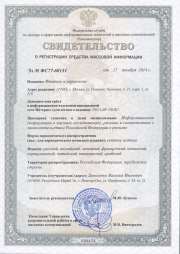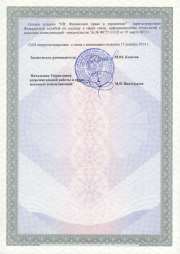MAIN PAGE
> Back to contents
Publications of Chesnokova Luiza Aleksandrovna
Chesnokova L.A., Yashina N.I., Malyshev S.A. - Problems of involving the youth into the agricultural sector of the Russian Federation
|
|
pp. 1-8
|
DOI: 10.7256/2453-8809.2018.3.27141
Abstract: The research subject is the problem of involving the youth into the restoration of the agricultural sector of the Russian Federation. The research object is the development of farming as a sector. Special attention is given to differentiating the youth problems in agriculture into the problems of employees and the problems of farmers-entrepreneurs. The authors emphasize the difficulties faced by small farmers. The authors consider the measures of direct and indirect government support in the area of farming and rural areas development in general. The authors study the works of foreign and Russian scientists, analyze statistical data provided by the Federal State Statistics Service and the Ministry of agriculture. The authors conclude about the necessity to consider and solve the problem of involving the youth into the agricultural sector using the two-way approach. At the current stage, it would be appropriate to use foreign experience and, along with solving the problems of the agricultural sector in general, train more targeted programmes of support for employees and self-employed farmers separately.

|
Taxes and Taxation, 2016-8
|
|
Chesnokova L.A., Malyshev S.A., Yashina N.I. - Factor Modeling of Receipts of Income tax in the Regional Budget
|
|
|
DOI: 10.7256/2454-065X.2016.8.19873
Abstract: The subject of the research is income tax revenues in the regional budget of the Russian Federation. The authors of the article analyze the possibility of using factor models for predicting tax revenues. The purpose of the research is to connect socio-economic indicators of regions with the volume of receipts of the income tax. To achieve the aforesaid target, it is necessary to allocate the factors defining receipts of income tax in the regional budget and to establish their mathematical dependence with the income tax. In order to achieve the reserach goals, the authors have chosen significant factors, and have constructed one-factor and two-factor mathematical models of receipt of income tax depending on qualititaive elements of the tax. The Nizhny Novgorod Region is chosen as the case study. Based on the analysis of data from the Federal Tax Service of the Russian Federation and Federal State Statistics Service of the Russian Federation the authors have created regression models. As a result of the research the authors have developed one-factor models to demonstrate the relation between the target indicator (the amount of the income tax received by the regional budget) and sign factors. They have also outlined two significant sign factors to be used in the two-factor model that would reflect the influence of indicators of the amount of tax payments on regional tax revenues (in the Nizhny Novgorod Region). To prove the significance and validity of the models the authors have used mathematical and statistical methods. All the models have been recognized as significant based on the research results. The authors of the present research have established the mathematical relationship (in the form of regression models) between income tax revenues and their determinant factors.

|
Taxes and Taxation, 2016-7
|
|
Chesnokova L.A., Yashina N.I., Kravchenko V.S. - Developing Factor Models of VAT Revenues in the Federal Budget
|
|
|
DOI: 10.7256/2454-065X.2016.7.18448
Abstract: The subject of the research is the value added tax revenues in the federal budget of the Russian Federation. This tax is received only at one budget level, thereat particular regions become the source of the taxation base. The purpose of the research is to relate socio-economic indicators of regions to amounts of VAT revenues for a particular constituent. To achieve this goal, the authors of the research make mathematical models of VAT revenues depending on the tax potential and elements of the tax. Nizhni Novgorod Region has been chosen as an example to draw one-factor models based on the analysis of the Federal Tax Service and Rosstat data. The scientific novelty of the research is caused by the fact that the authors have performed mathematical selection of the most important factors to be used in regression equations of VAT revenues in the federal budget. As a result of the research, the authors suggest that we should use six important factors that have the greatest influence on the development of VAT revenues.

|
Taxes and Taxation, 2016-6
|
|
Chesnokova L.A., Malyshev S.A., Yashina N.I. - Differentiation of VAT Revenues Between Budgets of Federal and Regional Levels
|
|
|
DOI: 10.7256/2454-065X.2016.6.18184
Abstract: The purpose of this research is to create a new approach to differentiation of taxes between levels of the budget system. The subject of the research is the value added tax (VAT). This article is the continuation of the research of redistribution of tax revenues between budget levels. Taking into account the algorithm developed by authors of the article, it is offered to redistribute the VAT. At the moment this indirect tax in the Russian Federation comes only to the federal budget. Considering that the majority of regional budgets have a subsidized focus, new approach to distribution of tax revenues can solve this problem. To achieve the research goals, the authors carried out the analysis of these forms of tax accounts for the period 2010-2014 for 83 constituents of the Russian Federation, interpreted theoretical criteria for distribution of taxes according to the aforesaid indicators, selected the criterial factor (variance factor), assessed the indicators for each constituent during a particular time period, defined the weighting value of each indicator and made conclusions about VAT differentiation. As a result of the research possible percentage intervals of distribution of VAT revenues for federal and regional budgets for 83 Russian Federation constituents are provided. The drawn conclusions can be used in the course of developing tax policy at a level of a specific region or the country in general.

|
Taxes and Taxation, 2016-4
|
|
Chesnokova L.A., Yashina N.I. - Creation of Algorithm of Distribution of Taxes in the Budgetary System
|
|
|
DOI: 10.7256/2454-065X.2016.4.16942
Abstract: The subject of the research is the possibility of application of quantitative indices for definition of criteria of differentiation of taxes depending on levels of the budgetary system and the algorithm of calculation of these indicators. The main purpose of the research is to develop unified quantitative criteria for distribution of taxes according to levels of the budgetary system. To fulfill the purpose, the following problems have been solved: 1) possible algorithm of calculation of similar criteria has been defined, 2) the systems of the auxiliary indicators have been developed, 3) the algorithm has been verified based on the sample data, 4) the system of indicators has been corrected according to the results of their verification. The authors develop the system of indicators for quantitative reflection of criteria of redistribution of taxes between regional and federal budget levels. The developed algorithm is checked on the basis of 22 randomly chosen territorial constituents of the Russian Federation for income tax. The criterion of mobility of tax base receives quantitative interpretation during research. The received values of coefficients are estimated from the point of view of statistical norms. The scientific novelty of the research is caused by the fact that the authors provide the qualitative interpretation of the criteria of the tax base mobility based on which profit tax revenues are distributed between federal and regional levels of the Russian Federation budget. It is concluded that theoretical criteria of distribution of taxes can be expressed through quantitative indexes. Indicators are used for percentage differentiation of taxes according to budget levels. This approach allows to distribute tax income between constituents of the Russian Federation most effectively taking into account their economic and territorial features. The priority of absolute values over the relative values on the first stages of calculation of indicators is revealed.

|
Finance and Management, 2016-2
|
|
Chesnokova L.A., Yashina N.I. - The Tax Burden in the Russian Federation Agricultural Sector and the Need to Change it
|
|
pp. 118-124
|
DOI: 10.7256/2409-7802.2016.2.16993
Abstract: The subject of the research is the tax burden of agricultural producers in the Russian Federation regions. As a result of the import substitution strategy, a Russian agricultural procuder is viewed as the provider of the basic products to the population. Based on different references, today Russian agricultural producers can provide 40% - 65% of the country's level of consumption. In order to avoid possible deficit, it is necessary to expand capacities and volumes of agricultural producers. The level of tax impact plays an important role in the development of this sphere. The purpose of the present resaerch is to define the level of the tax burden for each Russian Federation constituents and define regions with the greater tax burden. In the coruse of the research the authors have applied the methods of statistical and historical analysis of data presented on the website of the Federal Tax Service of the Russian Federation and Federal State Statistics Service of the Russian Federation. The novelty of the research is caused by the fact that the authors divide 83 Russian Federation constituents into 7 groups depending on their level of tax burden. As a result of the research the authors make a conclusion that the greater part of the Russian Federation constituents lie the average level of tax burden on agricultural producers, however, there are 10 Russian regions that suffer from increased tax burden.

|
Taxes and Taxation, 2015-9
|
|
Chesnokova L.A., Yashina N.I. - The Allocation of Tax Between the Federal and Regional Budgets on the Basis of Variation Coefficient
|
|
|
DOI: 10.7256/2454-065X.2015.9.14638
Abstract: Taxes are the main source of budgeting at all levels. The efficient tax allocation mechanism is that makes the budgeting system stable. At the present time allocation of taxes between budget levels is made on the basis of the theoretical criteria that don't have a practical justification. Such approach doesn't consider territorial or economic features of the Russian Federation constituents and therefore needs to be improved. The authors of the present article suggest that we should use variation coefficients as a threshold coefficient to differentiate receipts of tax between federal and regional budgets. The purpose of the research is to develop the system of indicators that will give the most accurate calculating of the variation of the time series for all indicators for each region of the Russian Federation. The methodological basis of the calculation presented in this article includes statistical formulas and axioms. In their research the authors have used the methods of analysis and forming groups of tax and statistical data for different regions of the Russian Federation. The main result of the research is the algorithm of the profit tax allocation developed by the authors for the Belgorod Region. Based on this algorithm, variation coefficients for each of the given 12 indicators have been calculated. According to the calculations, income tax can be attributed to the two levels of the budget. The percentage allocation of the tax is planned to be performed on the basis of the theory of weighted coefficient distribution.

|
Finance and Management, 2015-3
|
|
Chesnokova L.A., Yashina N.I. - Problems and directions of perfecting the tax position of banks
|
|
pp. 59-68
|
DOI: 10.7256/2409-7802.2015.3.14739
Abstract: The banking sector plays an important role in relations between tax agencies and tax payers – the role of a tax agent and a tax intermediary. According to the data of Russian statistic agencies, within the last 5 years, the country’s population’s tax competence increased from 2 to 3 times, depending on the region. More and more individual tax payers are starting to use their right for a tax rebate while paying personal income taxes into the budget. In this process, a bank plays the role of an “intermediary” between an individual and a tax agency, because direct transference of cash between them is not allowed. In such a situation, it is important for the bank to take into account the task risks that accompany the process of performing such a role. The scientific methods used by the author are analysis and evaluation of Russia’s current tax legislation and banking and tax statistic data. The main conclusions of the author are linked with his proposals of perfecting the legal status of banks in legal relations that have to do with taxes. Tax laws should take into account certain peculiarities of functioning of the banking sector, in particular, in their participation at the stock market, the ratability of credit operations with goods and services tax and the specificity of a bank’s intermediary activity as a participant of tax relations.

|






